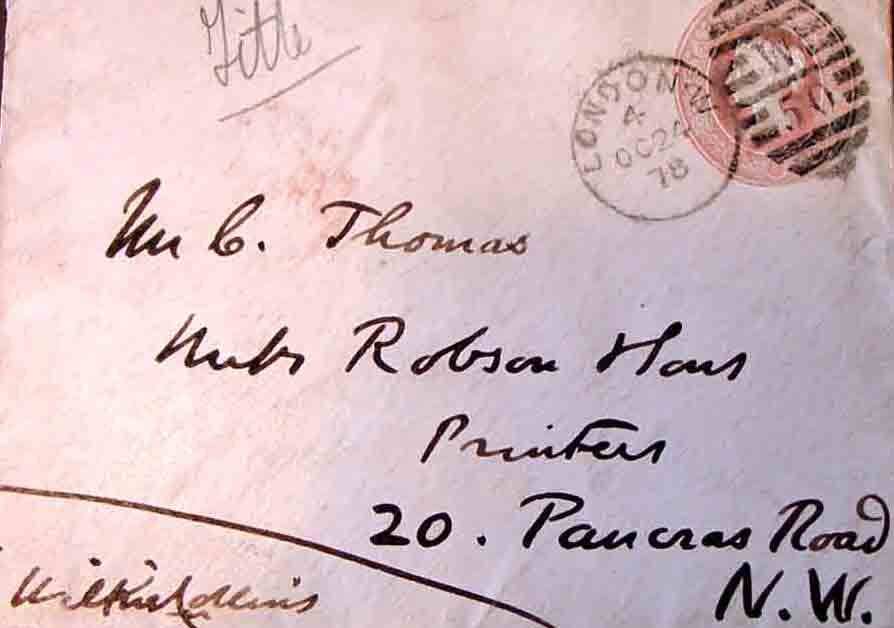"The handwriting wandered crookedly up and down, in deplorable freedom from all proper restraint." (Armadale, 1866)

In 1887 Cassell's Saturday Journal ran a series on the 'Handwriting of Eminent Persons'. Wilkie Collins was included in the issue for 11 June:
"The handwriting of Mr. Collins betrays great care and caution. The well-formed C denotes the artistic taste which no doubt he inherits from his parents. The closeness of the writing and its continuity tell us of his grip of ideas and the logical sequence of his mind. The calm, fair line betrays no subterfuge; but there are the tact and caution of the legal habit and the firmness of the hand that knows what it has to write about."
![]()
More recently, 'Notes on Handwriting Samples of Wilkie Collins between 1864 and 1889' were prepared for the Wilkie Collins Society by Andrea Lyttleton and are reproduced below:
A persuasive talker who had honed his communication skills that oil the social machinery to such an extent that they became incorporated into his personality. A well-educated man with a warm and sensuous nature and a love of life to whom materialistic pleasures were important. This could explain why, in spite of the increasing dependency on and increasing amounts of opium and morphine taken, there seems to be little obvious difference in the various samples of handwriting other than those attributable to failing health.
Collins had a quick, clear and active mind with ideas running away with him. He had a well-defined path of what he wanted to do with those images and the ability to channel his activities into reaching his goal. He would have little patience for those who were unable to follow his train of thought. In earlier samples, there is a sense of pride in himself and his mental capabilities, almost to the extent of superiority which he channelled into fulfilling his ambitions.
It would appear that his mother was the more influential figure of his parents in his childhood; her effect made a lasting impression upon him - softening the edges, making him more receptive and dulling the aggressive elements.
He had a sense of humour and fun and a strong will to go his own way, regardless of the conventions and consequences, with verve and enthusiasm. However, he needed the recognition and approval of his peers and he would actively seek it. This was not a man who was a loner, impervious to the views of others - he was dependent on company and appreciation and approbation.
Whilst he was clearly a man who enjoyed repartee with others, there is an underlying instability and excitability in some of the samples; the irritability and impulsiveness which lead to a tendency to fly off the handle indicate a lack of self-control and an inadequate restraint over his dominant instinctual desires. This appears to be in conflict with the more realistic and pragmatic side of his nature. He appeared to allow full rein to sensuous and worldly pleasures (not necessarily sexual) without anxiety and guilt - merely because this gratification of his desires was important to him. He appreciated and valued the good life and the good things of life, more material and physical than esoteric or academic.
|
30th December 1884 To Mrs Williams with sincere good wishes for the new year. Wilkie Collins
|
As he grew older and possibly more unwell, he appears to have become more confident and assertive. This is seen through the strength of the signature which is not followed through anywhere else; this could coincide with his public recognition. In the later samples, the strength of his joie de vivre and his needs diminish, leaving a more intellectual and intuitive side to come to the fore. This can be seen as his writing becomes smaller and more delicate or less dominating and frailer. Failing health can be detected in these later samples through the unevenness of the ink distribution which causes blotches.
The most interesting aspect from the graphological point of view is that the writing varies very little in spite of Collins's continuing drug habit; in modern day writings, it is usually possible to recognise either drug dependency or a psychological disturbance, but in these samples there is scant evidence of either.
A hedonistic, possibly even decadent, approach to life is clearly evident in the writing from the overall layout and size of the script. The right slant shows a decided preference for the company of others rather than for solitude. These observations are made mainly from photocopies but the prime feature of the writing is its strength and colour of the stroke. Also to be taken into account are the differences of paper and pen but the evidence still adds up to a powerful and charismatic character.
Andrea Lyttleton, June 1997
(For other specimens of Collins's handwriting see 'A Little Fable' and Publication Dates for The Woman in White)
Andrea Lyttleton is a qualified graphologist with an advanced diploma in personnel work from the British Academy of Graphology. She can be contacted at 2 Elm Walk, London, NW3 7UP. Telephone 0181-458 1000.